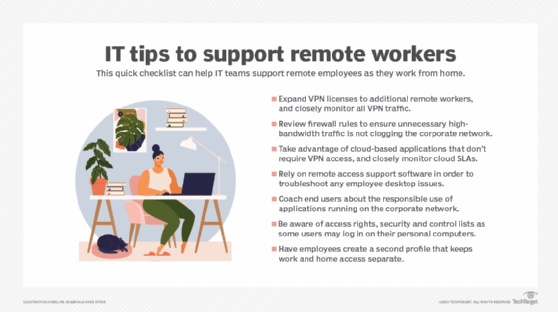
Getty Images/iStockphoto
15 advantages and disadvantages of remote work
Remote work can save businesses money and reduce absenteeism. But it also comes with its disadvantages.
Nearly every facet of life transitioned to an online format in 2020. But the biggest change was shifting from office work to remote work.
Teleworking is not a new idea. In the past, it was a luxury afforded to a lucky few. But its widespread adoption due to the pandemic became a benefit of the modern job. Many companies already had long-term goals to set up remote work environments, but the pandemic accelerated the process.
As the COVID-19 crisis begins to wane and vaccinations become more widespread, many people want to continue working remotely, at least on a part-time basis.
There are both advantages and disadvantages to remote work. Here are some things for businesses to keep in mind as the world emerges from lockdowns and into a new working environment.
Advantages of remote work
Some organizations settled into a work-from-home routine quickly. For others, it took time as they set up systems to enable remote work. Once organizations worked out the kinks, they found this new way of working had some benefits.
1. Better work-life balance
A frequent complaint in today's world is the difficulty of striking a good work-life balance. Working eight or more hours a day leaves little time for family -- especially when commutes and sleep are factored in. Working from home eliminates lengthy commutes, enabling more time with loved ones. And on days when employees aren't required to attend video meetings, they can dress any way they choose -- including pajamas. This greater sense of comfort and better work-life balance lead to less stress.
2. Higher productivity
Remote workers reported stable or increased productivity while working remotely compared to in an office, according to a Great Place to Work report. During 2020, the steepest productivity improvements came in April and May, during the height of the pandemic. Much of this was due to the elimination of daily commutes and lengthy in-person meetings.
3. Timeliness
When working from home, many of the factors that cause tardiness are reduced or removed. Eliminated factors include oversleeping, being stuck in traffic and waiting in a long line at the drive-through to get morning coffee. Being able to roll out of bed and start working is a huge time saver.
4. Reduced absenteeism and decreased turnover
Allowing remote work can help businesses retain employees and prevent absenteeism. When remote workers don't feel micromanaged and believe their employer trusts them, they are more likely to develop positive feelings toward organization leadership. In turn, workers will be less tempted to look elsewhere for employment, promoting a sense of loyalty and dedication. Even if workers aren't looking for new jobs, they might be less inclined to call out of work at random.
5. Cost savings
Remote teams enable businesses to rent smaller office spaces -- or even move to a remote, cloud-based operation completely. This saves organizations money on rent, utilities and other office supplies.
6. Flexibility
Remote work means employees can work from anywhere -- not just their home. Coffee shops, beaches and other countries are now options. If asynchronous work is appropriate, organizations can even extend operations beyond a typical 9 to 5 workday. Recent research from Microsoft has observed that many employees are now working a triple peak day, meaning they are working a few hours in the evening and freeing up time earlier in the day.
Flexible working hours can be a godsend to employees who are night owls, or to those who have small children. This freedom is invaluable for companies looking to stretch their working hours with a limited staff. It is also an attractive benefit that enables employers to draw from a deeper candidate pool in the hiring process.
7. Incentive to improve workplace technology
Organizations scrambled to put the right tools in place to enable remote work when the pandemic began. Many companies were using outdated tools, forcing them to upgrade their systems. At the time, some businesses were already experimenting with telework and were better able to meet this challenge. But even they had difficulty scaling from a handful of employees with remote work privileges to an entire workforce.
Companies needed businesses messengers, video conferencing platforms, timekeeping software, task management systems and cloud services to replace legacy systems and physical office processes. Then they needed VPNs and other cybersecurity tools to secure these systems. In the end, this technology investment helped organizations join the modern business world and put them on more equal footing.
Tip and tricks for using Teams and Zoom
Video conferencing platforms are an important piece of technology for remote employees to have in their toolbox. These tools act as a virtual office, enabling a scattered workforce to collaborate on projects, share screens and communicate face-to-face.
Two of the most popular video meeting tools in the business world are Microsoft Teams and Zoom. However, this technology isn't beneficial if employees don't know how to use it. Here are a couple of quick-start guides on using Teams and Zoom.
Disadvantages of remote work
While remote work has its advantages, it also has its disadvantages. Here are some things to consider before making it a permanent part of the work environment.
8. Distractions at home
There are many distractions at home that can detract from an employee's focus on their work. Some of these factors include screaming children, noise from passing traffic, ringing doorbells, dogs barking and household chores. If employees continue to work from home, it's important that they have a dedicated workspace, access to childcare and a schedule.
9. Isolation
Remote work -- especially for those who live alone -- can lead to feelings of loneliness and isolation. Even if an employee has their own office in a physical office building, they see others in the hallway, elevator and parking lot throughout the day. They also interact with people at gas stations, coffee shops and restaurants during their commute to work and their lunch. Workers may only exchange pleasantries, but it is in-person social interaction. Employees who work from home miss out on these conversations.
10. Loss of work-life balance
Though a better work-life balance is sometimes an advantage, many teleworkers find the opposite to be true. Some employees find that work bleeds over into their home life more and more. It can start as something simple, such as responding to an email after clocking out for the day. But if workers aren't careful, that can turn into multiple emails or putting in extra work after hours. For some, this turns an eight-hour day into a 10-hour day or more. This new schedule has been labelled the "infinite workday," since many workers now have a workday with no limits. The line between work life and home life becomes blurred when the workplace is inside the home, which can lead to burnout and lower morale.
11. Increased need for meetings
Once a company's employees are spread far and wide, leadership will want to keep tabs on them to some extent. In a remote work world, this means managers can no longer walk across the office to check in on their employees. Instead, they need to schedule virtual meetings to discuss routine project management tasks. While digital meetings can be less disruptive than in-person meetings, they are rarely the highlight of the workday. And having too many meetings often causes frustration among employees.
Read more here about the advantages and disadvantages of video conferencing.
12. Cybersecurity concerns
Security is always at the top of a business's list of priorities. But it becomes critical when an organization must accommodate remote working arrangements. A company's potential security loopholes increase when factoring in antivirus software, firewalls and VPN configurations for employees' home internet connections. Further complicating matters is when employees decide to work from a coffee shop or other location with public Wi-Fi, and when they bring personal devices onto a business network. Before the idea of remote work is even mentioned, businesses must be sure they can meet or exceed security expectations to minimize a cybersecurity disaster.

Learn more about how cybersecurity is a concern for remote workers.
13. Difficulty maintaining confidentiality
Organizations also must contend with the possibility of confidentiality breaches. This could include someone overhearing a confidential discussion or seeing sensitive documents on an employee's computer. Businesses must stress the importance of maintaining confidentiality, and consider limiting work in public spaces.
14. Unstable/inconsistent internet access
No one's internet connection is completely stable at every possible second. Electricity and internet outages aside, connections can vary in speed and reliability over the course of a day. For people in crowded areas where many others also work from home -- such as apartment complexes and densely packed cities -- slow speeds, buffering, and poor audio and video connections are common.
The problem is compounded by disparities in high-quality internet access throughout the country. Reliable internet service is still a commodity in rural areas. And home broadband access is generally less prevalent in Black and Hispanic residences compared to white residences, according to a PEW Research Center survey. Households reporting lower levels of education and income are also similarly restricted in terms of quality internet access.
15. Inconvenient for new hires
Starting a new job is stressful for most people, even under the best of circumstances. But new hires to an organization might feel overwhelmed if they are going from a traditional office to one primary based at home. Not only do they have to learn how to perform in their new role, but they must also learn to navigate new technology. As a result, managers may spend more time coaching a new remote employee.
Transitioning back to the office
After weighing the pros and cons of remote work, many businesses may want employees to return to the office. This could be full time or using a hybrid approach. Some employees may welcome this, and others may balk at the idea. It is up to the employer to make that transition as easy and painless for workers as possible. Here are some ways to ease the transition back to the office.
- Communicate openly and transparently. Don't bury the plans to move everyone back to the office at the bottom of the weekly company memo. Businesses need to tell employees as soon as they've decided to return to the office. Be sure employees are aware of the anticipated timeframe and kept informed as milestones are reached.
- Explain why the move is necessary. Employees don't need to know every detail about the transition plan, but they will appreciate honesty about why their employer wants them to go back into the office. They will also be more inclined to see the business's perspective if they see hard data to support this decision.
- Make employees aware of in-office changes. Organizations should be sure employees understand what is expected of them before returning to the office. This includes things such as continued enforcement of social distancing or allowing people to continue to work from home one or more days a week.
- Allow employees to offer input. Many organizations took employees' advice into account when entering lockdown. Workers told employers what tools would help them do their jobs more efficiently from a remote location. Likewise, businesses should hear employees out on what would help ease the transition back to the office.
- Have patience. Businesses should give employees time to adjust to working in the office again. This can be done by easing them back into regular office work while still working from home part time. Also, ask for employee feedback on easing any anxieties or uncertainties during the transition. And make sure employees know what resources the company has to offer, such as on-site daycare facilities.






